Chapter 17 Hairstyling Learning Objectives Execute finger waving

Chapter 17 Hairstyling

Learning Objectives • Execute finger waving, pin curling, roller setting, and hair wrapping. • Perform various blowdry styling techniques and learn the proper use of blowdrying tools. • Demonstrate the proper use of thermal irons. • Demonstrate the proper use of a flat iron and show an understanding of heat settings. • Demonstrate various thermal iron manipulations and explain how they are used. (continues)

Learning Objectives (continued) • Perform the four basic curl patterns and explain the end result. • Describe three types of hair pressing. • Understand the importance of preparation, sectioning, pinning, and balance with regard to updos. • Create the two foundational updos for styling long hair.

Introduction • We can’t call ourselves hairdressers if we only concentrate on one area of our craft. • A hairdresser is a professional with well-rounded skills that can adapt to the individual needs of the guest. • By mastering “hair-dressing” we will not only learn discipline but finger dexterity or the manipulation of our hands.

Start with a Client Consultation • The consultation is always the first step in the hairstyling process. • Be sure to have your portfolio and a variety of styling books available for review.


Learn the Basics of Wet Hairstyling Tools • • • Combs Brushes Rollers Pins Clips Clamps

Perform Finger Waving • Process of shaping and directing the hair into an S pattern through the use of the fingers, combs, and finger-waving lotion. • Finger waving was all the rage in the 1920 s and 1930 s, and continues to be popular on today’s runways and in Hollywood.

Finger-Waving Lotion • • • Makes hair pliable and holds it in place Made of karaya gum Diluted for use on fine hair Concentrated for regular or coarse hair Harmless to hair; no flakes when dry Avoid excessive amounts

Other Methods of Finger Waving • Vertical • Horizontal


Form Pin Curls • Parts of a Curl – Base – Stem – Circle

Mobility of a Curl • No-stem curl • Half-stem curl • Full-stem curl

Shaping for Pin Curl Placements • Begin at open end of a shaping.

Open- and Closed-Center Curls • Open-center curls • Closed-center curls

Curl and Stem Direction • Forward movement • Reverse movement • Upward movement • Downward movement • Diagonally • Clockwise • Counterclockwise

Pin Curl Bases or Foundations • Rectangular base • Arc base • Triangular base • Square base

Pin Curl Techniques • Ribboning • Carved/sculptured curls

Designing with Pin Curls • Ridge curls • Skip waves (continues)

Designing with Pin Curls (continued) • Barrel curls

Creating Volume with Pin Curls • Cascade curls

Create Roller Curls • Speed • Increased strength • Greater creativity

Parts of a Roller Curl • Base • Stem • Curl

Choosing Roller Size • C-shaped curl • Wave • Curls

Roller Placement • On base • Half base • Off base

Roller Direction • Follows the direction of a finished style • Indentation – the point where curls of opposite directions meet

Hot and Velcro Rollers • Hot rollers – used on dry hair only; heated electrically or by steam • Velcro™ rollers – used on dry hair only for 5 to 10 minutes (not allowed in some states)

Backcombing Technique • • • Section hair Insert comb Press comb to scalp Create cushion base Repeat for volume Smooth hair


Backbrushing Technique • • • Hold strand Place brush Roll brush Turn brush Blend hair Complete styling

Hair Wrapping • Keeps curly hair smooth and straight while retaining a beautiful shape. • Very little volume is attained because the hair at the scalp is not lifted. • Wrapping can be done on wet or dry hair. – Dry hair, use a silicone shine product instead of gel. – Wet wrapping creates a smooth, sleek look.

Finish Hair Using Basic Blowdry Styling Guidelines to Follow when Blowdry Styling • Do not hold the dryer too long in one place. • Use a constant back and forth motion. • Always direct the hot air away from the client’s scalp. • Direct air from the scalp toward the ends of the hair. • Partially towel dry the hair before blowdrying

Tools for Blowdry Styling • Blowdryer – Handle – Slotted nozzle – Small fan – Heating element – Speed/heat controls – Diffuser

Combs and Picks

Brushes • • • Classic styling brush Paddle brush Grooming brush Vent brush Round brush Teasing brush

Sectioning Clips • Usually metal or plastic • Have long prongs to hold wet or dry sections of hair in place. • Keeps wet hair sectioned off and separate from the section being styled

Types of Styling Product • Foam or mousse • Gels • Liquid gels or texturizers • Straightening gels (continues)

Types of Styling Product (continued) • Volumizers • Pomade or wax • Silicone • Hair spray or finishing spray • Thermal protection product


Maintain Safety in Thermal Hairstyling • Methods of waving and curling straight or pressed dry hair using thermal irons and special manipulative techniques

Thermal Irons • Four parts – Rod handle – Shell handle – Barrel or rod – Shell

Flat Irons • Range in size from ½ inch to 3 inches across • Used to create smooth, straight styles

Testing Thermal Irons • Heat iron. • Clamp heated iron over tissue. • Note if paper scorches. • Let cool as needed.

Care of Thermal Irons • Be sure to check the manufacturer’s directions for care and cleaning. • Dampen a towel or rag and wipe down the barrel of the iron with a soapy solution containing a few drops of ammonia. • If you are using a nonelectrical thermal iron, immerse the barrel in this solution. • Do not clean your iron when it is turned on or when it is still cooling from a previous styling service.

Comb Used with Thermal Irons • Size • Holding comb

Manipulating Thermal Irons • Grasp handles with dominant hand. • Place three middle fingers on back of lower handle, with little finger in front and thumb in front of upper handle. • Practice rolling cold irons.

Temperature • Setting depends on the texture of the hair, whether it is fine or coarse, and whether it has been lightened or tinted. • Hair that has been lightened or tinted, as well as white hair, should be curled and waved with a gentle heat. • As a rule, coarse and gray hair can withstand more heat than fine hair.

Thermal Curling with Electric Thermal Irons • Straight hair • Pressed hair • Wigs and hairpieces

Curling Iron Manipulations • • Practice turning the iron Practice releasing the hair Practice guiding the hair strand Practice removing the curl from iron

The 4 Basic Curl Patterns • • Root curl Spiral curl Waves End curls

Volume-Base Thermal Curls • • • Section off base. Hold strand at 135 -degree angle. Slide iron over strand. Wrap strand over rod with medium tension. Maintain position for five seconds. Roll curl and place on base.

Full-Base Thermal Curls • • • Section off base. Hold strand at 125 -degree angle. Slide iron over strand. Wrap strand with medium tension. Maintain position for five seconds. Roll curl and place firmly on base.

Half-Base Thermal Curls • • • Section off base. Hold hair at 90 -degree angle. Slide iron over hair strand. Wrap strand over rod with medium tension. Maintain position for five seconds. Roll curl and place it half on base.

Off-Base Thermal Curls • • • Section off base. Hold hair at 70 -degree angle. Slide iron over strand. Wrap strand over rod with medium tension. Maintain position for five seconds. Roll curl and place off base.

© Zoom Team/Shutterstock. com © Valua Vitaly/Shutterstock. com Finished Thermal Curl Settings

Using Thermal Irons Safely • Get instructions for use of irons. • Keep irons clean. • Do not overheat. • Test temperature. • Handle carefully. • Place hot irons in safe place to cool. (continues)

Using Thermal Irons Safely (continued) • Don’t place handles too close to heater. • Properly balance irons in heater. • Use hard rubber or nonflammable combs. • Do not use metal combs. • Place comb between scalp and iron. (continues)

Using Thermal Irons Safely (continued) • Curl only clean, dry hair. • Avoid fishhooks. • Use gentle setting on chemically-treated hair. • Use proper technique to avoid lines of demarcation. • Always use a thermal protection product.
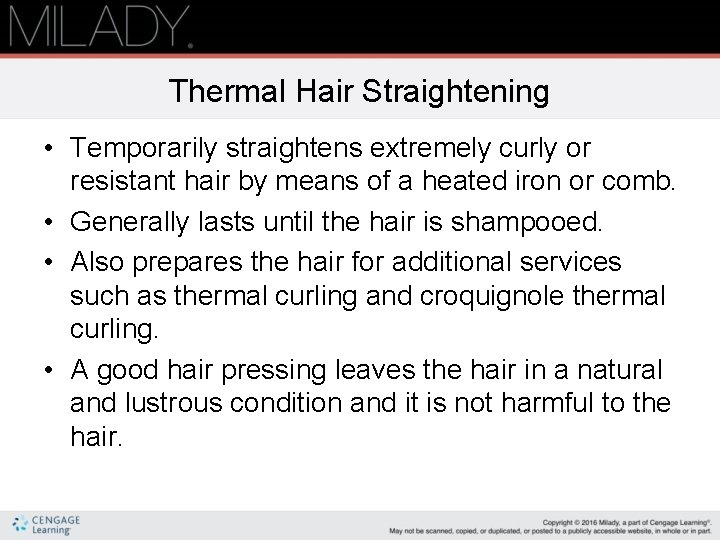
Thermal Hair Straightening • Temporarily straightens extremely curly or resistant hair by means of a heated iron or comb. • Generally lasts until the hair is shampooed. • Also prepares the hair for additional services such as thermal curling and croquignole thermal curling. • A good hair pressing leaves the hair in a natural and lustrous condition and it is not harmful to the hair.

Three Types of Hair Straightening • Soft press • Medium press • Hard press
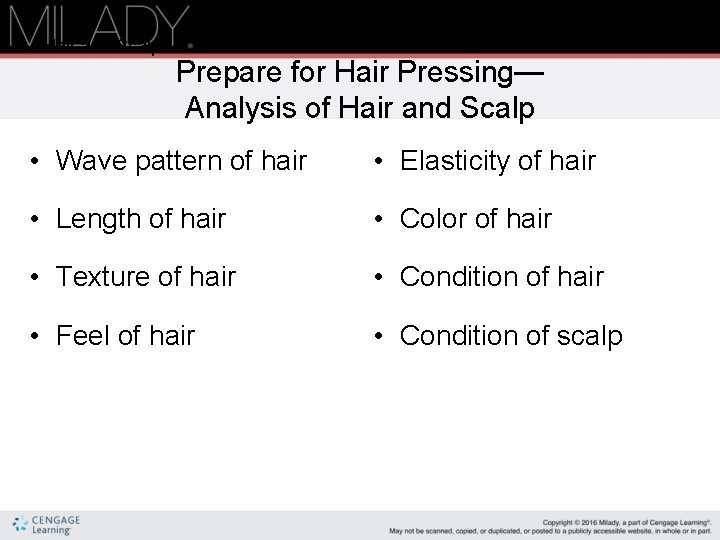
Hair and Scalp Prepare for Hair Pressing— Analysis of Hair and Scalp • Wave pattern of hair • Elasticity of hair • Length of hair • Color of hair • Texture of hair • Condition of hair • Feel of hair • Condition of scalp

Hair Texture • Coarse, overly curly • Medium • Fine • Wiry
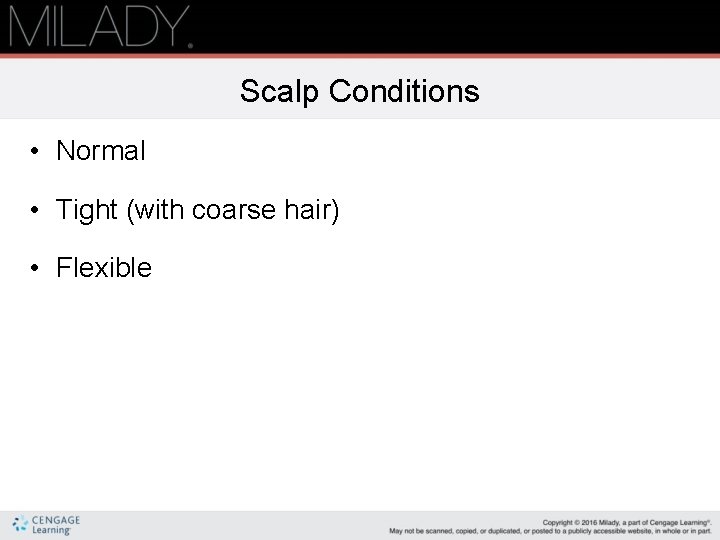
Scalp Conditions • Normal • Tight (with coarse hair) • Flexible
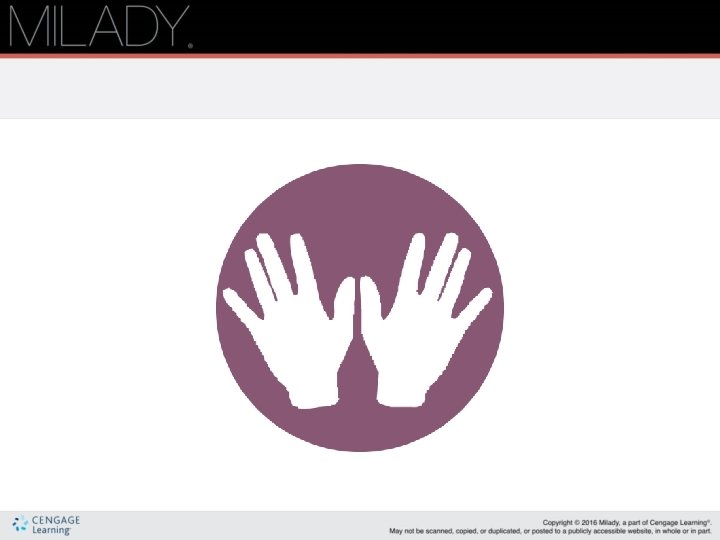
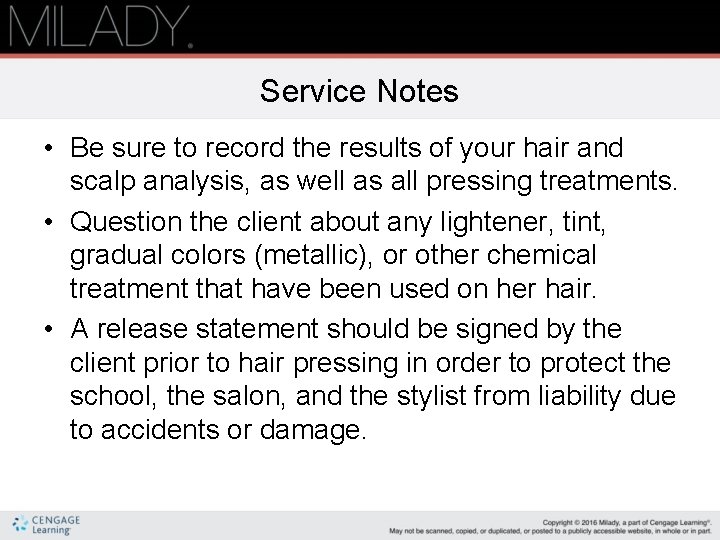
Service Notes • Be sure to record the results of your hair and scalp analysis, as well as all pressing treatments. • Question the client about any lightener, tint, gradual colors (metallic), or other chemical treatment that have been used on her hair. • A release statement should be signed by the client prior to hair pressing in order to protect the school, the salon, and the stylist from liability due to accidents or damage.
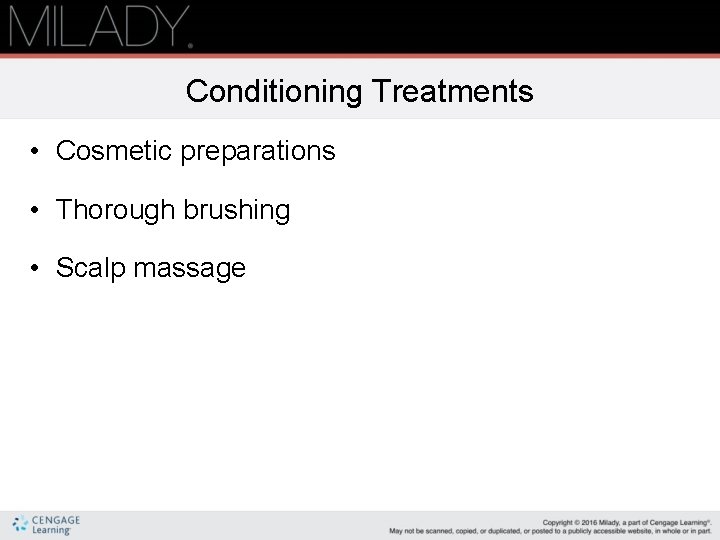
Conditioning Treatments • Cosmetic preparations • Thorough brushing • Scalp massage
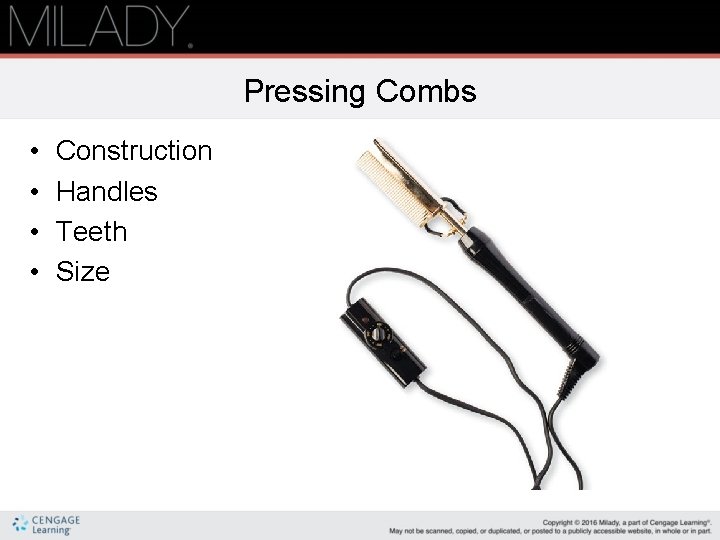
Pressing Combs • • Construction Handles Teeth Size
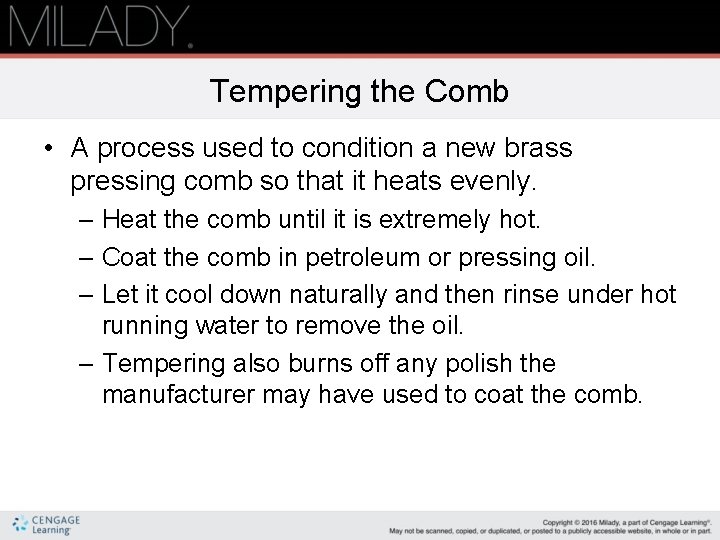
Tempering the Comb • A process used to condition a new brass pressing comb so that it heats evenly. – Heat the comb until it is extremely hot. – Coat the comb in petroleum or pressing oil. – Let it cool down naturally and then rinse under hot running water to remove the oil. – Tempering also burns off any polish the manufacturer may have used to coat the comb.
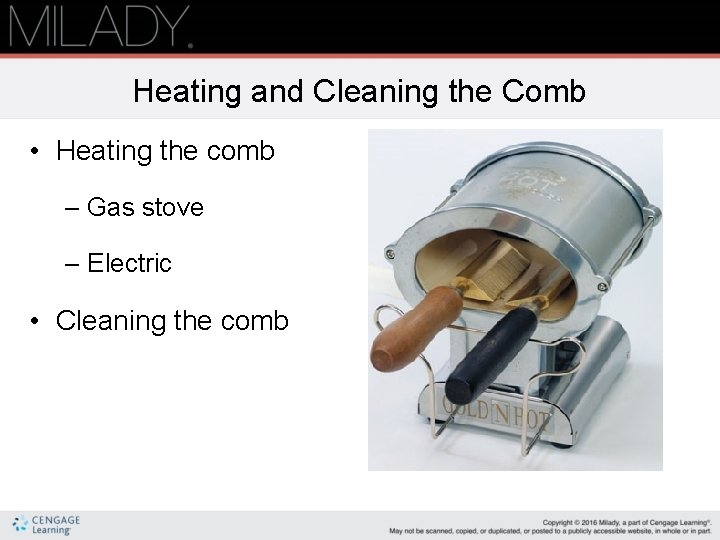
Heating and Cleaning the Comb • Heating the comb – Gas stove – Electric • Cleaning the comb
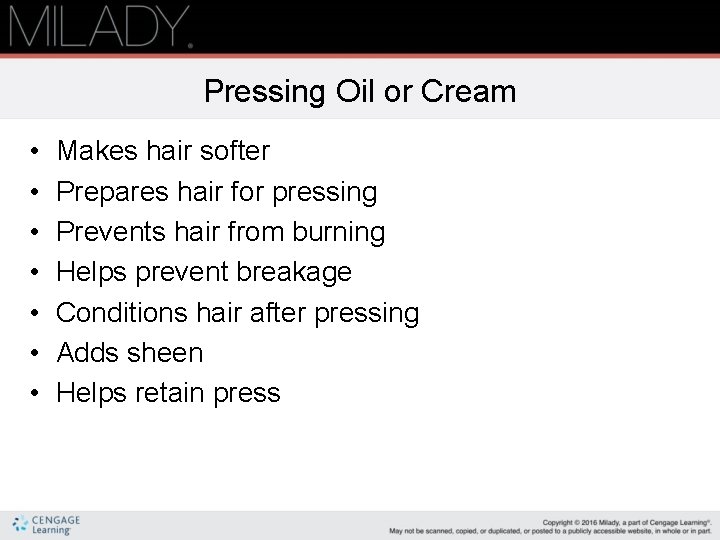
Pressing Oil or Cream • • Makes hair softer Prepares hair for pressing Prevents hair from burning Helps prevent breakage Conditions hair after pressing Adds sheen Helps retain press
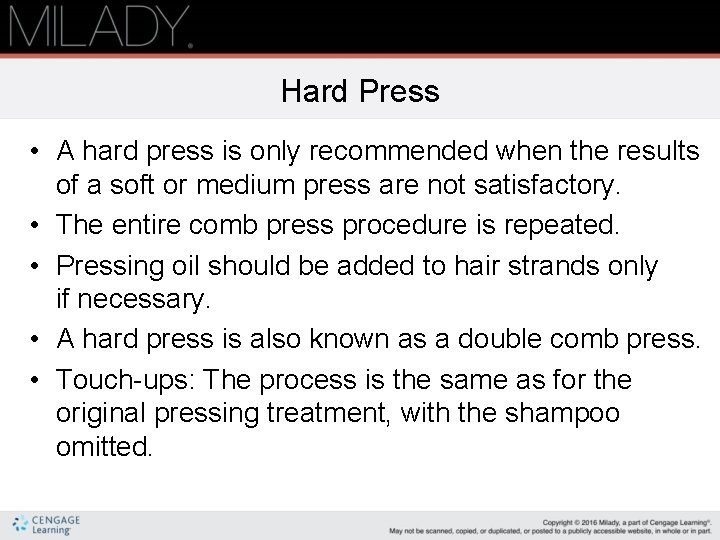
Hard Press • A hard press is only recommended when the results of a soft or medium press are not satisfactory. • The entire comb press procedure is repeated. • Pressing oil should be added to hair strands only if necessary. • A hard press is also known as a double comb press. • Touch-ups: The process is the same as for the original pressing treatment, with the shampoo omitted.
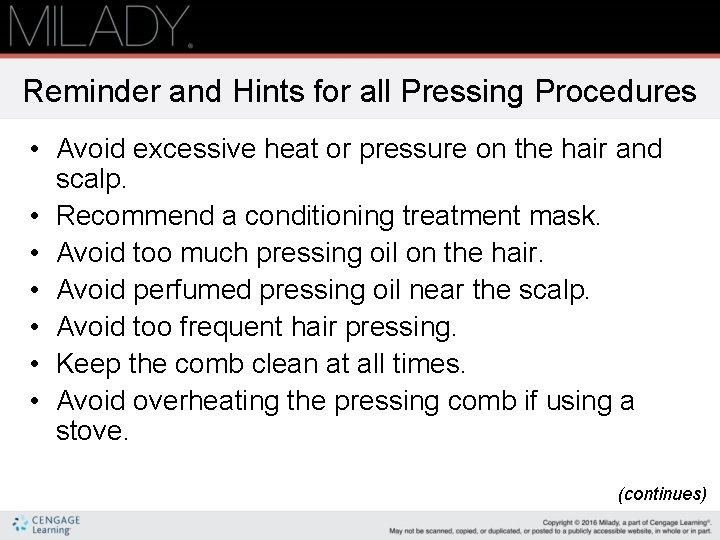
Reminder and Hints for all Pressing Procedures • Avoid excessive heat or pressure on the hair and scalp. • Recommend a conditioning treatment mask. • Avoid too much pressing oil on the hair. • Avoid perfumed pressing oil near the scalp. • Avoid too frequent hair pressing. • Keep the comb clean at all times. • Avoid overheating the pressing comb if using a stove. (continues)
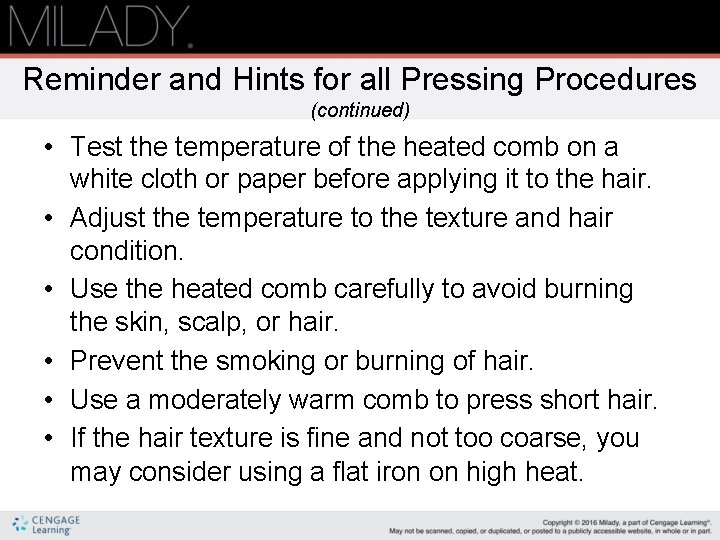
Reminder and Hints for all Pressing Procedures (continued) • Test the temperature of the heated comb on a white cloth or paper before applying it to the hair. • Adjust the temperature to the texture and hair condition. • Use the heated comb carefully to avoid burning the skin, scalp, or hair. • Prevent the smoking or burning of hair. • Use a moderately warm comb to press short hair. • If the hair texture is fine and not too coarse, you may consider using a flat iron on high heat.
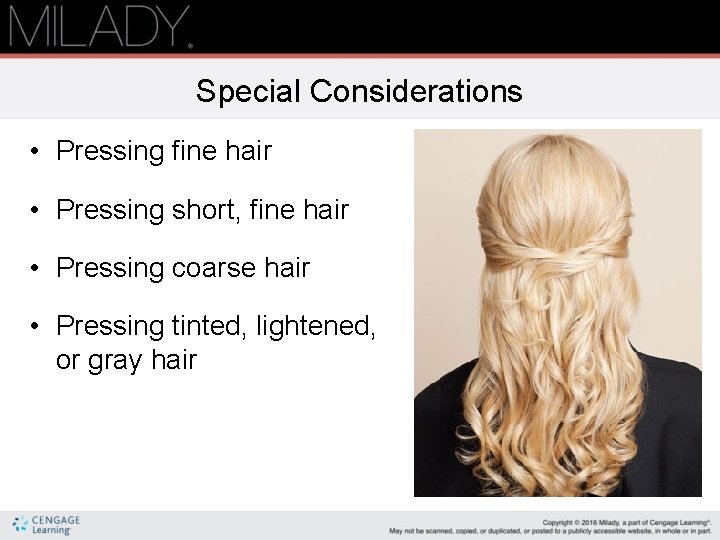
Special Considerations • Pressing fine hair • Pressing short, fine hair • Pressing coarse hair • Pressing tinted, lightened, or gray hair
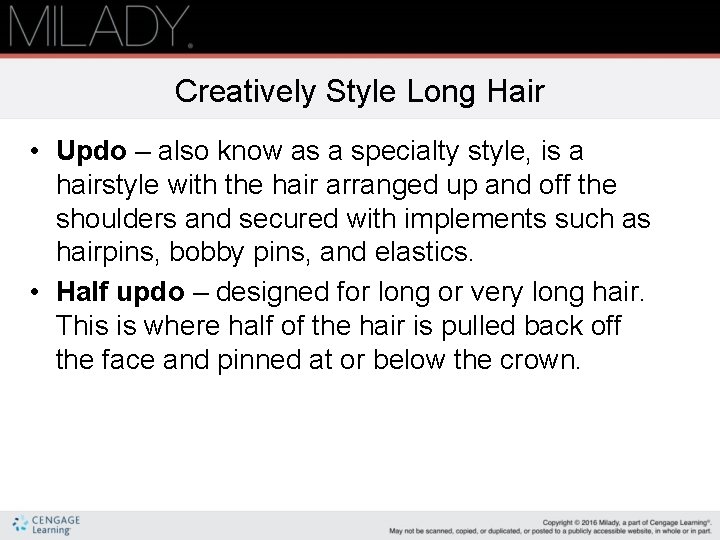
Creatively Style Long Hair • Updo – also know as a specialty style, is a hairstyle with the hair arranged up and off the shoulders and secured with implements such as hairpins, bobby pins, and elastics. • Half updo – designed for long or very long hair. This is where half of the hair is pulled back off the face and pinned at or below the crown.
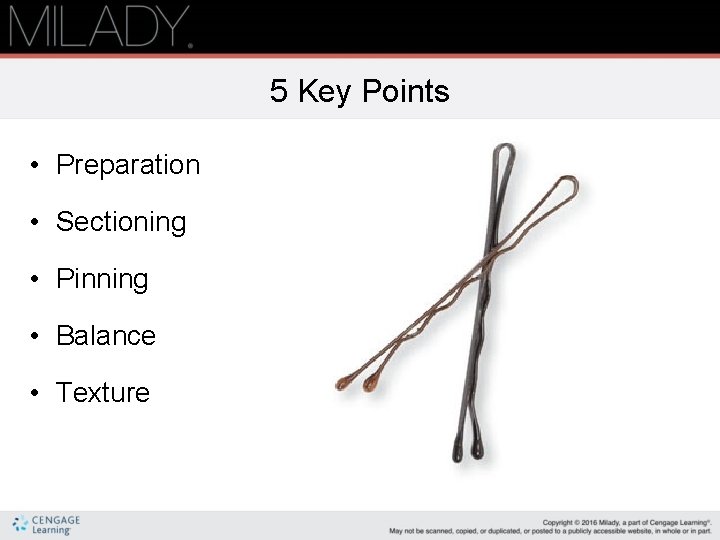
5 Key Points • Preparation • Sectioning • Pinning • Balance • Texture
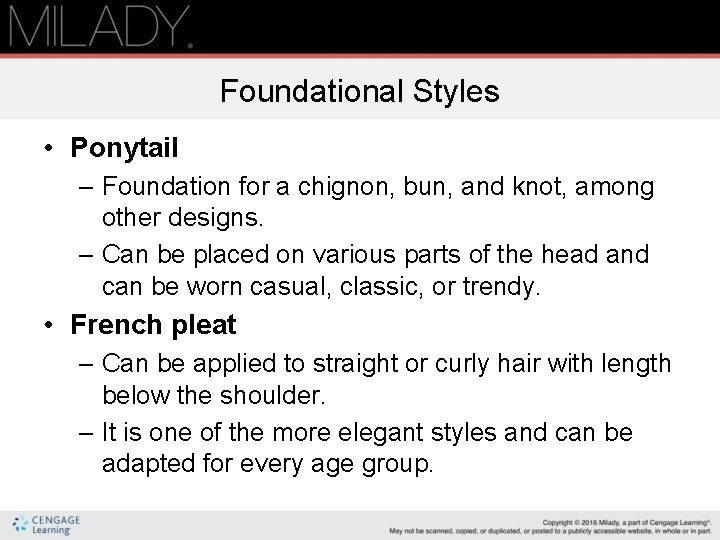
Foundational Styles • Ponytail – Foundation for a chignon, bun, and knot, among other designs. – Can be placed on various parts of the head and can be worn casual, classic, or trendy. • French pleat – Can be applied to straight or curly hair with length below the shoulder. – It is one of the more elegant styles and can be adapted for every age group.
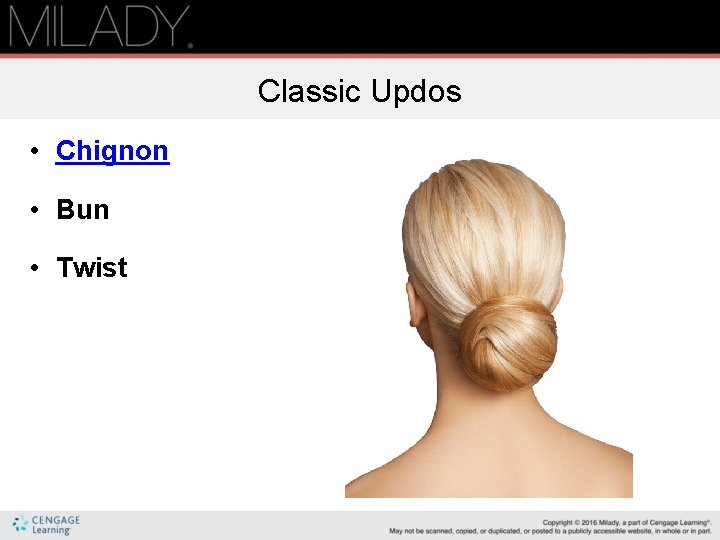
Classic Updos • Chignon • Bun • Twist
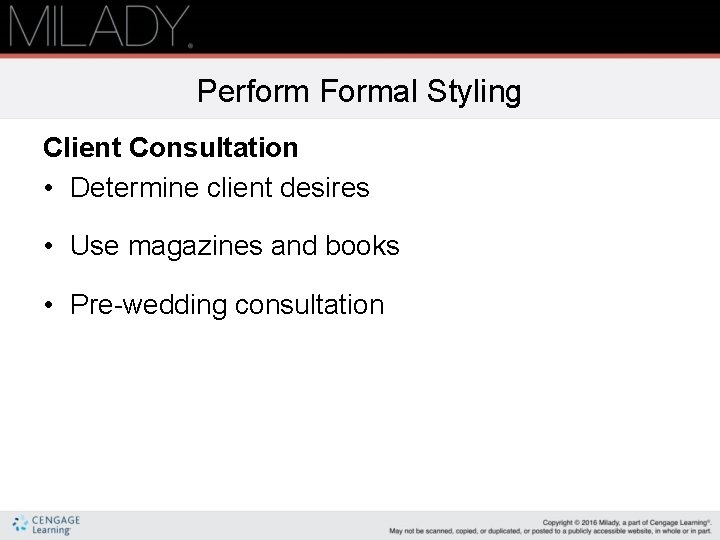
Perform Formal Styling Client Consultation • Determine client desires • Use magazines and books • Pre-wedding consultation
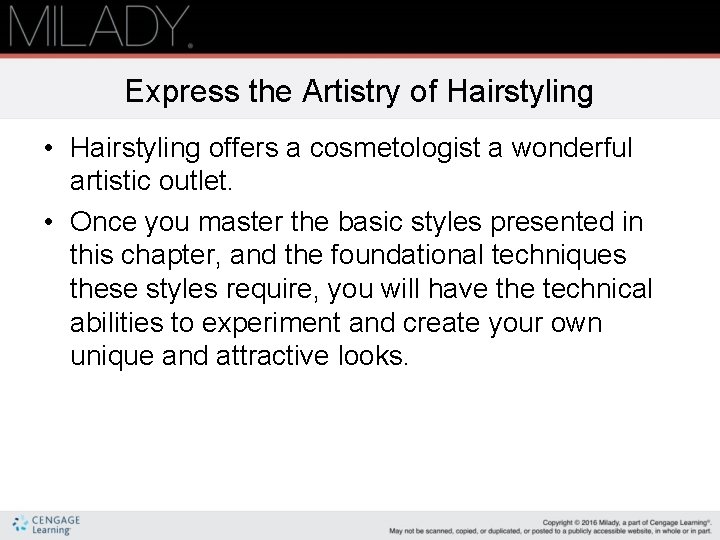
Express the Artistry of Hairstyling • Hairstyling offers a cosmetologist a wonderful artistic outlet. • Once you master the basic styles presented in this chapter, and the foundational techniques these styles require, you will have the technical abilities to experiment and create your own unique and attractive looks.
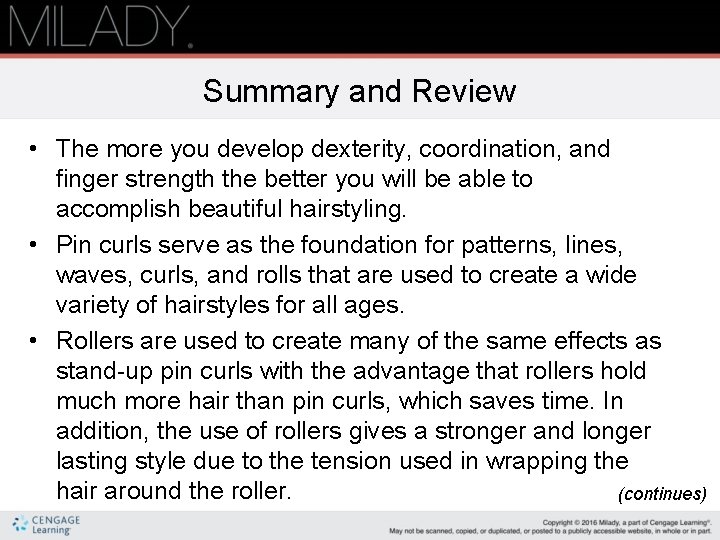
Summary and Review • The more you develop dexterity, coordination, and finger strength the better you will be able to accomplish beautiful hairstyling. • Pin curls serve as the foundation for patterns, lines, waves, curls, and rolls that are used to create a wide variety of hairstyles for all ages. • Rollers are used to create many of the same effects as stand-up pin curls with the advantage that rollers hold much more hair than pin curls, which saves time. In addition, the use of rollers gives a stronger and longer lasting style due to the tension used in wrapping the hair around the roller. (continues)
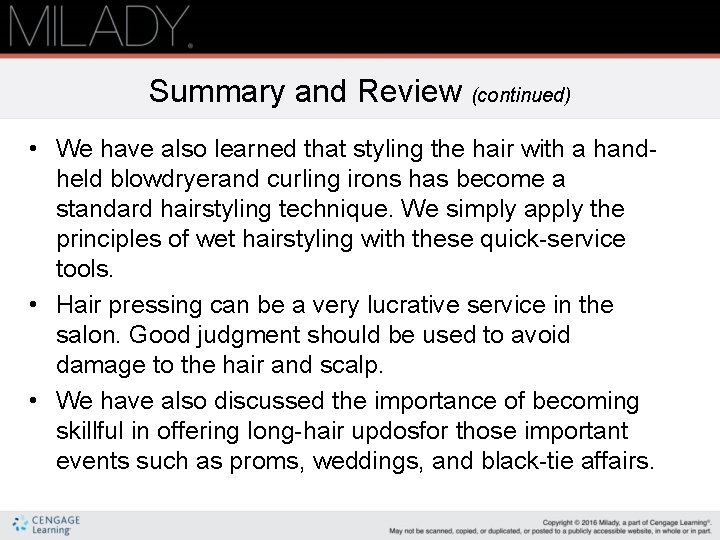
Summary and Review (continued) • We have also learned that styling the hair with a handheld blowdryerand curling irons has become a standard hairstyling technique. We simply apply the principles of wet hairstyling with these quick-service tools. • Hair pressing can be a very lucrative service in the salon. Good judgment should be used to avoid damage to the hair and scalp. • We have also discussed the importance of becoming skillful in offering long-hair updosfor those important events such as proms, weddings, and black-tie affairs.
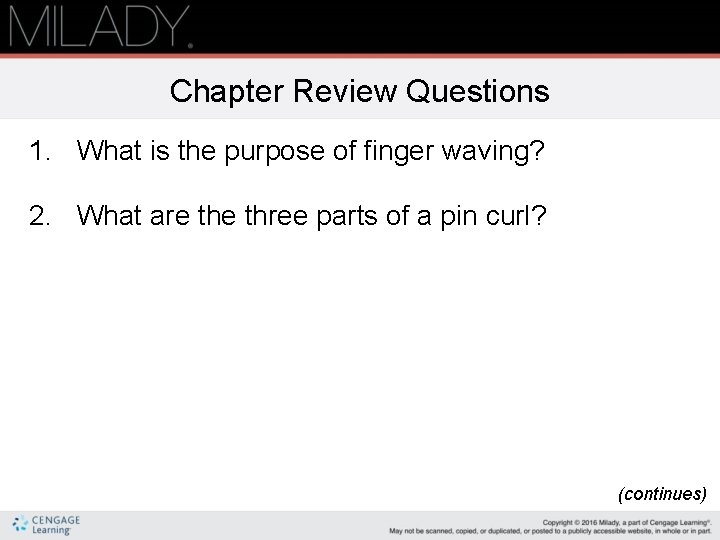
Chapter Review Questions 1. What is the purpose of finger waving? 2. What are three parts of a pin curl? (continues)
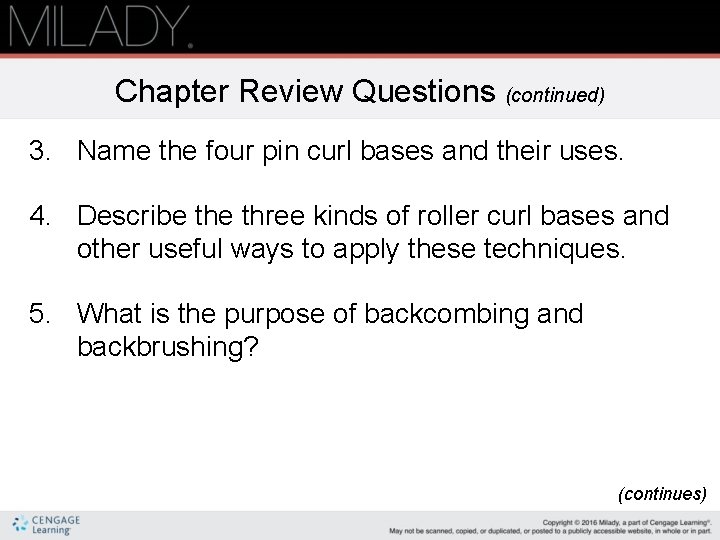
Chapter Review Questions (continued) 3. Name the four pin curl bases and their uses. 4. Describe three kinds of roller curl bases and other useful ways to apply these techniques. 5. What is the purpose of backcombing and backbrushing? (continues)
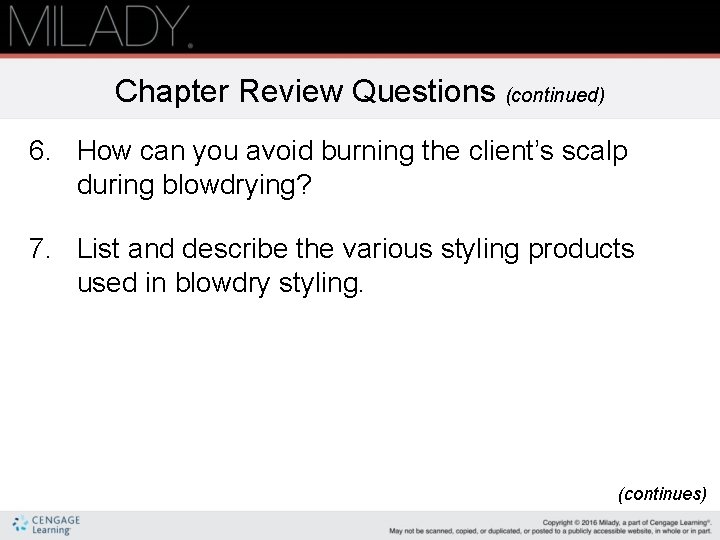
Chapter Review Questions (continued) 6. How can you avoid burning the client’s scalp during blowdrying? 7. List and describe the various styling products used in blowdry styling. (continues)
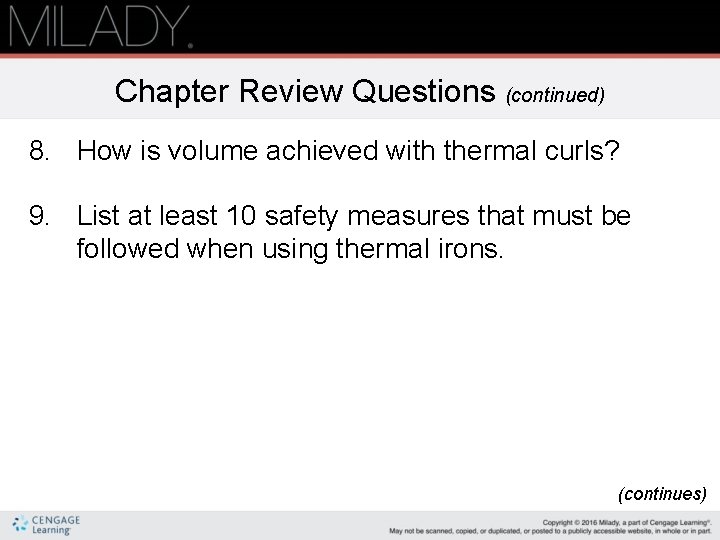
Chapter Review Questions (continued) 8. How is volume achieved with thermal curls? 9. List at least 10 safety measures that must be followed when using thermal irons. (continues)
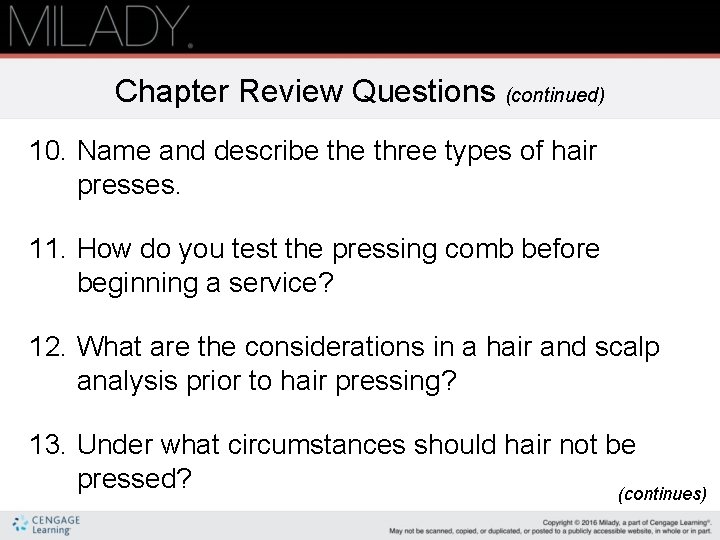
Chapter Review Questions (continued) 10. Name and describe three types of hair presses. 11. How do you test the pressing comb before beginning a service? 12. What are the considerations in a hair and scalp analysis prior to hair pressing? 13. Under what circumstances should hair not be pressed? (continues)
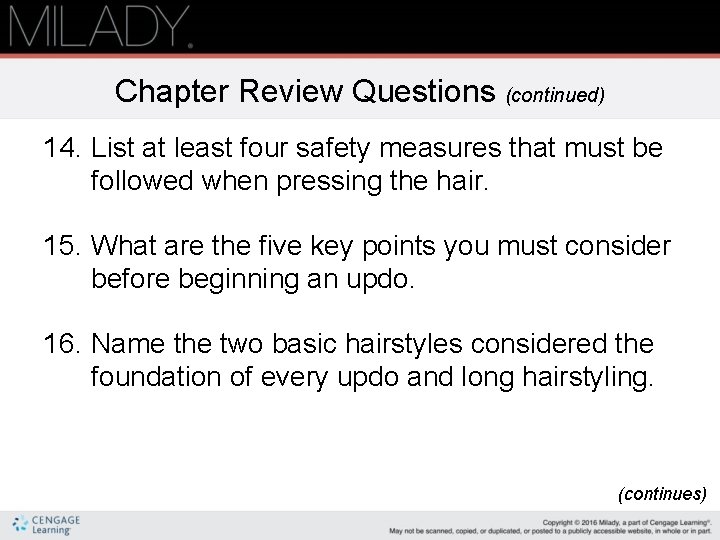
Chapter Review Questions (continued) 14. List at least four safety measures that must be followed when pressing the hair. 15. What are the five key points you must consider before beginning an updo. 16. Name the two basic hairstyles considered the foundation of every updo and long hairstyling. (continues)
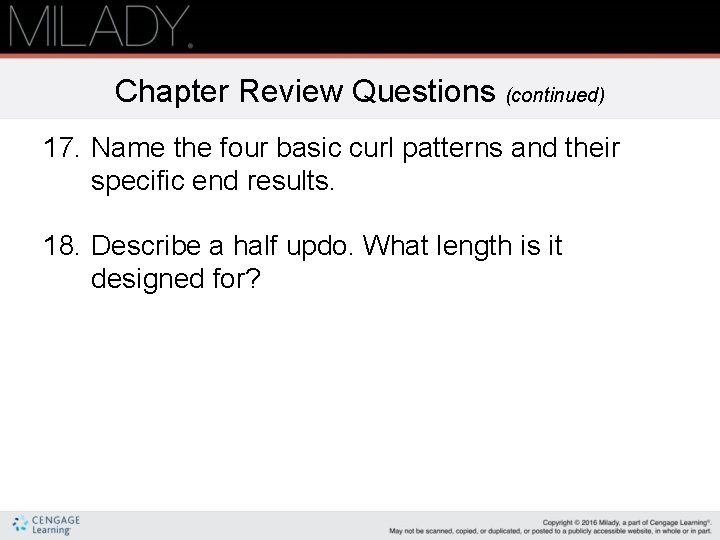
Chapter Review Questions (continued) 17. Name the four basic curl patterns and their specific end results. 18. Describe a half updo. What length is it designed for?
- Slides: 89